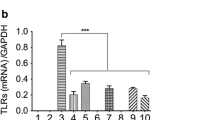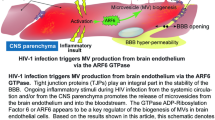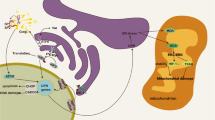Abstract
The recombinant HIV-1 CRF02_AG is prevalent in West-Central Africa but its effects on the blood-brain barrier (BBB) and HIV-associated neurocognitive disorders (HAND) are not known. We analyzed the effects of Tat from HIV-1 subtype-B (Tat.B) and CRF02_AG (Tat.AG) on primary human brain microvascular endothelial cells (HBMEC), the major BBB component. Exposure of HBMEC to Tat.B increased IL-6 expression and transcription by 9- (P < 0.001) and 113-fold (P < 0.001), respectively, whereas Tat.AG increased IL-6 expression and transcription by 2.7–3.8-fold and 35.7-fold (P < 0.001), respectively. Tat.B induced IL-6 through the interleukin-1 receptor-associated kinase (IRAK)-1/4/mitogen-activated protein kinase kinase(MKK)/C-jun N-terminal kinase(JNK) pathways, in an activator protein-1(AP1)- and nuclear factor-kappaB (NFκB)-independent manner, whereas Tat.AG effects occurred via MKK/JNK/AP1/NFκB pathways. Tat-induced effects were associated with activation of c-jun (serine-63) and SAPK/JNK (Thr183/Tyr185). We demonstrated increased expression of transcription factors associated with these pathways (Jun, RELB, CEBPA), with higher levels in Tat.B-treated cells compared to Tat.AG. Functional studies showed that Tat.B and Tat.AG decreased the expression of tight junction proteins claudin-5 and ZO-1 and decreased the trans-endothelial electric resistance (TEER); Tat.B induced greater reduction in TEER, claudin-5, and ZO-1, compared to Tat.AG. Overall, our data showed increased inflammation and BBB dysfunction with Tat.B, compared to Tat.AG. This suggests these two HIV-1 subtypes differentially affect the BBB and central nervous system; our data provides novel insights into the molecular basis of these differential Tat-mediated effects.






Similar content being viewed by others
References
Antinori A, Arendt G, Becker JT, Brew BJ, Byrd DA, Cherner M, Clifford DB, Cinque P et al (2007) Updated research nosology for HIV-associated neurocognitive disorders. Neurology 69(18):1789–1799. doi:10.1212/01.WNL.0000287431.88658.8b
Banks WA, Ercal N, Price TO (2006) The blood-brain barrier in neuroAIDS. Curr HIV Res 4(3):259–266
Persidsky Y, Ramirez SH, Haorah J, Kanmogne GD (2006) Blood-brain barrier: structural components and function under physiologic and pathologic conditions. J NeuroImmune Pharmacol 1(3):223–236. doi:10.1007/s11481-006-9025-3
Bannwarth S, Gatignol A (2005) HIV-1 TAR RNA: the target of molecular interactions between the virus and its host. Curr HIV Res 3(1):61–71
Gupta S, Mitra D (2007) Human immunodeficiency virus-1 tat protein: immunological facets of a transcriptional activator. Indian J Biochem Biophys 44(5):269–275
Westendorp MO, Frank R, Ochsenbauer C, Stricker K, Dhein J, Walczak H, Debatin KM, Krammer PH (1995) Sensitization of T cells to CD95-mediated apoptosis by HIV-1 tat and gp120. Nature 375(6531):497–500. doi:10.1038/375497a0
Banks WA, Robinson SM, Nath A (2005) Permeability of the blood-brain barrier to HIV-1 tat. Exp Neurol 193(1):218–227. doi:10.1016/j.expneurol.2004.11.019
Hudson L, Liu J, Nath A, Jones M, Raghavan R, Narayan O, Male D, Everall I (2000) Detection of the human immunodeficiency virus regulatory protein tat in CNS tissues. J Neurovirol 6(2):145–155
UNAIDS (2015) Fact sheet 2015: global statistics. http://www.unaids.org/sites/default/files/media_asset/20150901_FactSheet_2015_enpdf
WHO/UNAIDS (2015) AIDS by the numbers 2015. http://www.unaids.org/en/resources/documents/2015/AIDS_by_the_numbers_2015
Anastassopoulou CG, Kostrikis LG (2006) Global genetic variation of HIV-1 infection. Curr HIV Res 4(3):365–373
Robertson DLAJ, Bradac JA, Carr JK, Foley B et al (2000) HIV-1 nomenclature proposal. Science 288:55–56
LANL (2016) HIV circulating recombinant forms (CRFs). HIV sequence database http://www.hivlanl.gov/content/sequence/HIV/CRFs/CRFshtml
Montavon C, Toure-Kane C, Liegeois F, Mpoudi E, Bourgeois A, Vergne L, Perret JL, Boumah A et al (2000) Most env and gag subtype A HIV-1 viruses circulating in west and west Central Africa are similar to the prototype AG recombinant virus IBNG. J Acquir Immune Defic Syndr 23(5):363–374
Brennan CA, Bodelle P, Coffey R, Devare SG, Golden A, Hackett J Jr, Harris B, Holzmayer V et al (2008) The prevalence of diverse HIV-1 strains was stable in Cameroonian blood donors from 1996 to 2004. J Acquir Immune Defic Syndr 49(4):432–439. doi:10.1097/QAI.0b013e31818a6561
PRB (2010) 2010 world population data sheet. http://www.prb.org. The Population Reference Bureau, Washington DC
Woollard SM, Bhargavan B, Yu F, Kanmogne GD (2014) Differential effects of Tat proteins derived from HIV-1 subtypes B and recombinant CRF02_AG on human brain microvascular endothelial cells: implications for blood-brain barrier dysfunction. J Cereb Blood Flow Metab 34(6):1047–1059. doi:10.1038/jcbfm.2014.54
Chaudhuri A, Yang B, Gendelman HE, Persidsky Y, Kanmogne GD (2008) STAT1 signaling modulates HIV-1-induced inflammatory responses and leukocyte transmigration across the blood-brain barrier. Blood 111(4):2062–2072. doi:10.1182/blood-2007-05-091207
Yang B, Akhter S, Chaudhuri A, Kanmogne GD (2009) HIV-1 gp120 induces cytokine expression, leukocyte adhesion, and transmigration across the blood-brain barrier: modulatory effects of STAT1 signaling. Microvasc Res 77(2):212–219. doi:10.1016/j.mvr.2008.11.003
Kanmogne GD, Schall K, Leibhart J, Knipe B, Gendelman HE, Persidsky Y (2007) HIV-1 gp120 compromises blood-brain barrier integrity and enhances monocyte migration across blood-brain barrier: implication for viral neuropathogenesis. J Cereb Blood Flow Metab 27(1):123–134. doi:10.1038/sj.jcbfm.9600330
Maggirwar SB, Tong N, Ramirez S, Gelbard HA, Dewhurst S (1999) HIV-1 Tat-mediated activation of glycogen synthase kinase-3beta contributes to Tat-mediated neurotoxicity. J Neurochem 73(2):578–586
Silvers JM, Aksenova MV, Aksenov MY, Mactutus CF, Booze RM (2007) Neurotoxicity of HIV-1 Tat protein: involvement of D1 dopamine receptor. Neurotoxicology 28(6):1184–1190. doi:10.1016/j.neuro.2007.07.005
Eugenin EA, King JE, Nath A, Calderon TM, Zukin RS, Bennett MV, Berman JW (2007) HIV-tat induces formation of an LRP-PSD-95- NMDAR-nNOS complex that promotes apoptosis in neurons and astrocytes. Proc Natl Acad Sci U S A 104(9):3438–3443. doi:10.1073/pnas.0611699104
Zhou BY, Liu Y, Kim B, Xiao Y, He JJ (2004) Astrocyte activation and dysfunction and neuron death by HIV-1 Tat expression in astrocytes. Mol Cell Neurosci 27(3):296–305. doi:10.1016/j.mcn.2004.07.003
Toborek M, Lee YW, Pu H, Malecki A, Flora G, Garrido R, Hennig B, Bauer HC et al (2003) HIV-Tat protein induces oxidative and inflammatory pathways in brain endothelium. J Neurochem 84. doi:10.1046/j.1471-4159.2003.01543.x
Ranga U, Shankarappa R, Siddappa NB, Ramakrishna L, Nagendran R, Mahalingam M, Mahadevan A, Jayasuryan N et al (2004) Tat protein of human immunodeficiency virus type 1 subtype C strains is a defective chemokine. J Virol 78(5):2586–2590
Campbell GR, Watkins JD, Singh KK, Loret EP, Spector SA (2007) Human immunodeficiency virus type 1 subtype C Tat fails to induce intracellular calcium flux and induces reduced tumor necrosis factor production from monocytes. J Virol 81(11):5919–5928. doi:10.1128/JVI.01938-06
Carr JK, Salminen MO, Albert J, Sanders-Buell E, Gotte D, Birx DL, McCutchan FE (1998) Full genome sequences of human immunodeficiency virus type 1 subtypes G and A/G intersubtype recombinants. Virology 247(1):22–31. doi:10.1006/viro.1998.9211
Tanaka T, Narazaki M, Kishimoto T (2014) IL-6 in inflammation, immunity, and disease. Cold Spring Harb Perspect Biol 6(10). doi:10.1101/cshperspect.a016295
Tanaka T, Narazaki M, Ogata A, Kishimoto T (2014) A new era for the treatment of inflammatory autoimmune diseases by interleukin-6 blockade strategy. Semin Immunol 26(1):88–96. doi:10.1016/j.smim.2014.01.009
Rossi J-F, Lu Z-Y, Jourdan M, Klein B (2015) Interleukin-6 as a therapeutic target. Clin Cancer Res 21(6):1248–1257. doi:10.1158/1078-0432.ccr-14-2291
Bastard JP, Soulie C, Fellahi S, Haim-Boukobza S, Simon A, Katlama C, Calvez V, Marcelin AG et al (2012) Circulating interleukin-6 levels correlate with residual HIV viraemia and markers of immune dysfunction in treatment-controlled HIV-infected patients. Antivir Ther 17(5):915–919. doi:10.3851/IMP2093
Hamlyn E, Fidler S, Stohr W, Cooper DA, Tambussi G, Schechter M, Miro JM, McClure M et al (2014) Interleukin-6 and D-dimer levels at seroconversion as predictors of HIV-1 disease progression. AIDS 28(6):869–874. doi:10.1097/QAD.0000000000000155
Olwenyi OA, Naluyima P, Cham F, Quinn TC, Serwadda D, Sewankambo NK, Gray RH, Sandberg JK et al (2016) Brief report: differential associations of interleukin 6 and intestinal fatty acid-binding protein with progressive untreated HIV-1 infection in Rakai, Uganda. J Acquir Immune Defic Syndr 72(1):15–20. doi:10.1097/QAI.0000000000000915
Kalayjian RC, Machekano RN, Rizk N, Robbins GK, Gandhi RT, Rodriguez BA, Pollard RB, Lederman MM et al (2010) Pretreatment levels of soluble cellular receptors and interleukin-6 are associated with HIV disease progression in subjects treated with highly active antiretroviral therapy. J Infect Dis 201(12):1796–1805. doi:10.1086/652750
Boulware DR, Hullsiek KH, Puronen CE, Rupert A, Baker JV, French MA, Bohjanen PR, Novak RM et al (2011) Higher levels of CRP, D-dimer, IL-6, and hyaluronic acid before initiation of antiretroviral therapy (ART) are associated with increased risk of AIDS or death. The Journal of infectious diseases 203(11):1637–1646. doi:10.1093/infdis/jir134
French MA, Cozzi-Lepri A, Arduino RC, Johnson M, Achhra AC, Landay A (2015) Plasma levels of cytokines and chemokines and the risk of mortality in HIV-infected individuals: a case-control analysis nested in a large clinical trial. AIDS 29(7):847–851. doi:10.1097/QAD.0000000000000618
Borges ÁH, O’Connor JL, Phillips AN, Neaton JD, Grund B, Neuhaus J, Vjecha MJ, Calmy A et al (2016) Interleukin 6 is a stronger predictor of clinical events than high-sensitivity C-reactive protein or D-dimer during HIV infection. J Infect Dis 214(3):408–416. doi:10.1093/infdis/jiw173
Kuller LH, Tracy R, Belloso W, De Wit S, Drummond F, Lane HC, Ledergerber B, Group ISS et al (2008) Inflammatory and coagulation biomarkers and mortality in patients with HIV infection. PLoS Med 5(10):e203. doi:10.1371/journal.pmed.0050203
Nordell AD, McKenna M, Borges ÁH, Duprez D, Neuhaus J, Neaton JD, the Insight Smart ESG, Committee SS (2014) Severity of cardiovascular disease outcomes among patients with HIV is related to markers of inflammation and coagulation. Journal of the American Heart Association: Cardiovascular and Cerebrovascular Disease 3(3):e000844. doi:10.1161/jaha.114.000844
Hsu DC, Ma YF, Hur S, Li D, Rupert A, Scherzer R, Kalapus SC, Deeks S et al (2016) Plasma IL-6 levels are independently associated with atherosclerosis and mortality in HIV-infected individuals on suppressive antiretroviral therapy. AIDS 30(13):2065–2074. doi:10.1097/QAD.0000000000001149
McDonald B, Moyo S, Gabaitiri L, Gaseitsiwe S, Bussmann H, Koethe JR, Musonda R, Makhema J et al (2013) Persistently elevated serum interleukin-6 predicts mortality among adults receiving combination antiretroviral therapy in Botswana: results from a clinical trial. AIDS Res Hum Retrovir 29(7):993–999. doi:10.1089/AID.2012.0309
Gandhi N, Saiyed Z, Thangavel S, Rodriguez J, Rao KV, Nair MP (2009) Differential effects of HIV type 1 clade B and clade C Tat protein on expression of proinflammatory and antiinflammatory cytokines by primary monocytes. AIDS Res Hum Retrovir 25(7):691–699. doi:10.1089/aid.2008.0299
Kallunki T, Deng T, Hibi M, Karin M (1996) c-Jun can recruit JNK to phosphorylate dimerization partners via specific docking interactions. Cell 87(5):929–939
Gupta S, Barrett T, Whitmarsh AJ, Cavanagh J, Sluss HK, Derijard B, Davis RJ (1996) Selective interaction of JNK protein kinase isoforms with transcription factors. EMBO J 15(11):2760–2770
Akira S, Kishimoto T (1992) IL-6 and NF-IL6 in acute-phase response and viral infection. Immunol Rev 127:25–50
Ambrosino C, Ruocco MR, Chen X, Mallardo M, Baudi F, Trematerra S, Quinto I, Venuta S et al (1997) HIV-1 Tat induces the expression of the interleukin-6 (IL6) gene by binding to the IL6 leader RNA and by interacting with CAAT enhancer-binding protein beta (NF-IL6) transcription factors. J Biol Chem 272(23):14883–14892
Ohno H, Kaneko S, Lin Y, Kobayashi K, Murakami S (1999) Human hepatitis B virus X protein augments the DNA binding of nuclear factor for IL-6 through its basic-leucine zipper domain. J Med Virol 58(1):11–18
Nookala AR, Kumar A (2014) Molecular mechanisms involved in HIV-1 Tat-mediated induction of IL-6 and IL-8 in astrocytes. J Neuroinflammation 11(1):1–18. doi:10.1186/s12974-014-0214-3
Shah A, Verma AS, Patel KH, Noel R, Rivera-Amill V, Silverstein PS, Chaudhary S, Bhat HK et al (2011) HIV-1 gp120 induces expression of IL-6 through a nuclear factor-kappa B-dependent mechanism: suppression by gp120 specific small interfering RNA. PLoS One 6. doi:10.1371/journal.pone.0021261
Gangwani MR, Kumar A (2015) Multiple protein kinases via activation of transcription factors NF-κB, AP-1 and C/EBP-δ regulate the IL-6/IL-8 production by HIV-1 Vpr in astrocytes. PLoS One 10(8):e0135633. doi:10.1371/journal.pone.0135633
Toborek M, Lee YW, Flora G, Pu H, Andras IE, Wylegala E, Hennig B, Nath A (2005) Mechanisms of the blood-brain barrier disruption in HIV-1 infection. Cell Mol Neurobiol 25(1):181–199
Dallasta LM, Pisarov LA, Esplen JE, Werley JV, Moses AV, Nelson JA, Achim CL (1999) Blood-brain barrier tight junction disruption in human immunodeficiency virus-1 encephalitis. Am J Pathol 155(6):1915–1927
Boven LA, Middel J, Verhoef J, De Groot CJ, Nottet HS (2000) Monocyte infiltration is highly associated with loss of the tight junction protein zonula occludens in HIV-1-associated dementia. Neuropathol Appl Neurobiol 26(4):356–360
Acknowledgements
This work was supported by grant from the National Institute of Health, National Institute of Mental Health R01 MH094160.
Authors’ Contributions
B.B. carried out immunoassays, real-time PCR, Western blot, TEER, adhesion and migration assays and participated in the making of the figures and tables, data analysis, and writing the methods and results. G.D.K. conceived and designed the study, participated in the making of the figures and tables, data analysis, and wrote the manuscript.
Author information
Authors and Affiliations
Corresponding author
Ethics declarations
Conflicting Interests
The authors declare that they have no conflict of interest.
Appendix
Appendix
Exposure of primary HBMEC to Tat proteins (1, 10, 100, or 1000 ng/ml) increased IL-6 levels. At similar doses, higher IL-6 expression was observed in Tat.B-treated cells, compared to cells exposed to Tat.AG. *P < 0.05; ***P < 0.001, compared to cells treated with heat-inactivated proteins and untreated controls. For all experiments, each experimental condition was performed in triplicate
Rights and permissions
About this article
Cite this article
Bhargavan, B., Kanmogne, G.D. Differential Mechanisms of Inflammation and Endothelial Dysfunction by HIV-1 Subtype-B and Recombinant CRF02_AG Tat Proteins on Human Brain Microvascular Endothelial Cells: Implications for Viral Neuropathogenesis. Mol Neurobiol 55, 1352–1363 (2018). https://doi.org/10.1007/s12035-017-0382-0
Received:
Accepted:
Published:
Issue Date:
DOI: https://doi.org/10.1007/s12035-017-0382-0





